The origin of our species
By Jenny Wong and Lisa Hendry
Our Human Evolution gallery explores the origins of Homo sapiens, tracing our lineage since it split from that of our closest living relatives, the chimpanzee and the bonobo.Gallery developer Jenny Wong tells us more....
The gallery takes visitors on an epic journey spanning the last seven million years.
Starting in Africa with our early hominin relatives (who are more closely related to us than to chimpanzees), visitors will travel forward in time to meet our ancient human relatives as they spread into Europe and Asia. The journey ends with modern humans as the only surviving human species in the world today.
Along the way, visitors can see star specimens from the Museum collections, and get to grips with some of the latest research shedding light on our past.
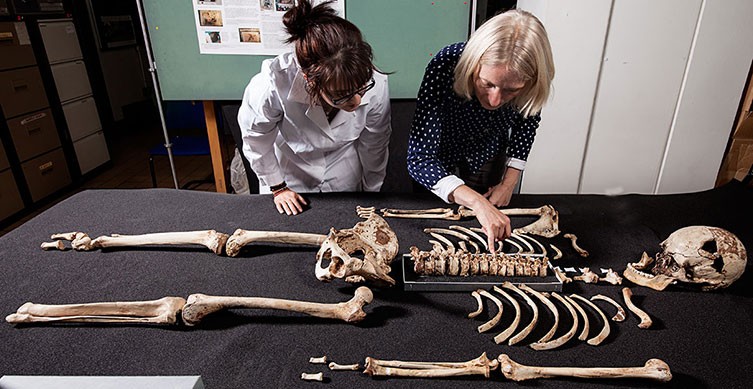 |
Conservator Effie Verveniotou and human origins researcher Dr Louise Humphrey examine the oldest nearly complete modern human skeleton ever found in Britain before it goes on display in the gallery. Cheddar Man lived around 10,000 years ago. |
A great saga
The story of human evolution is not one of neat, linear progression with a concrete beginning and end. Instead, it is a tale of a family tree whose complex and bushy branches stretch over many millennia and continents. It features a changing cast of ancient hominin relatives, evolutionary dead-ends and many unknowns. Adaptation, survival and extinction provide the dynamic backdrop to this story.
By piecing together fossil traces, scientists are revealing what our ancient relatives were like, how they were related and how they adapted to life in different landscapes and challenging climates.
Meet the ancient relatives
Entering the gallery, visitors meet hominins like us and our extinct australopithecine relatives, comparing them to non-hominins like the chimpanzee to explore the differences.
The human lineage split from the chimpanzee lineage around seven million years ago. Fossil evidence relating to the earliest hominins that lived after this split is scarce, but it provides important clues about how our ancient relatives lived.
From the six- to seven-million-year-old Sahelanthropus tchadensis skull found in Chad, we know that they had evolved small canines, while six-million-year-old Orrorin tugenensis leg bones show that they exhibited primitive bipedalism (walking on two legs).
Visitors can further investigate the key hominin traits of habitually walking upright and having small canines that aren't used as weapons, using an interactive digital touchscreen.
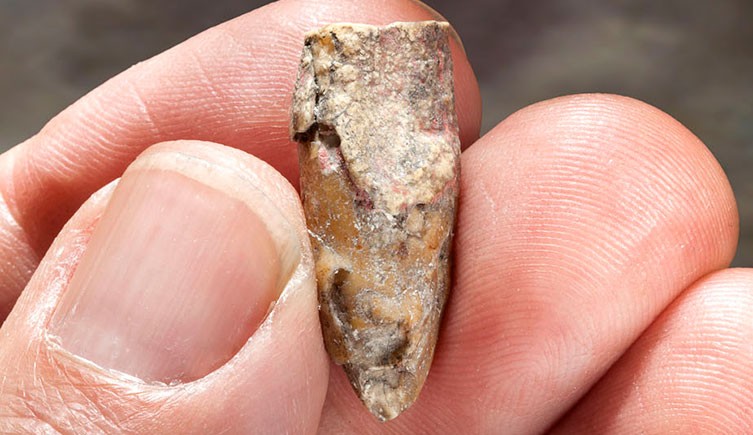 |
| The 3.5-million-year-old Laetoli canine belonging to Australopithecus afarensisis the oldest hominin fossil in the Museum's collection |
Visitors to the gallery will also be able to see a replica of one of the most famous bipedal hominins, the Australopithecus afarensis known as Lucy, who lived around 3.2 million years ago.
By around two million years ago, several australopithecine species like Lucy had evolved and spread across southern and eastern Africa. Fossil remains show that they had adapted to survive in different ecological niches by altering their diets.
Scientists think that some form of australopithecine is likely to have given rise to the next phase of human evolution, the genus Homo.
What is a human?
There have been many species similar to us that have lived over the last two million years. Some co-existed with modern humans in Asia and Europe as recently as 40,000 years ago.
Who these relatives were, and how they lived, is the subject of the next part of the gallery.
Apart from our species, the gallery features eight other kinds of human: Homo habilis, Homo rudolfensis, Homo erectus, Homo antecessor, Homo heidelbergensis, Homo floresiensis (nicknamed 'the hobbit'), Homo neanderthalensis (the Neanderthals) and the recently discovered Homo naledi. The mysterious Denisovans, who may or may not turn out to be a distinct species, also make an appearance.
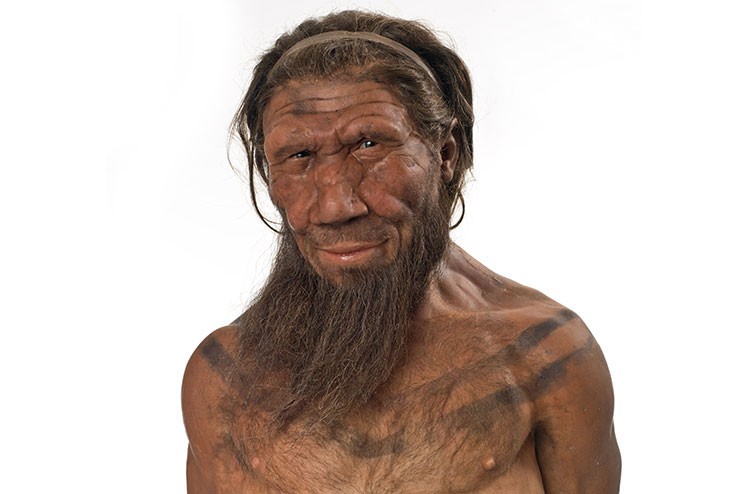 |
| Scientifically accurate Homo neanderthalensis model by Kennis & Kennis. Neanderthals survived in Europe until the species went extinct about 39,000 years ago. |
Fossil specimens, casts and other objects on display provide a series of snapshots in time, offering visitors glimpses of our ancient relatives' lives.
Exhibits include a flint handaxe possibly made by Homo heidelbergensis and a butchered rhino skull whose brains were extracted and eaten by ancient humans in Sussex, England around 500,000 years ago.
Visitors can investigate a Neanderthal burial and other clues about Neanderthal behaviour, such as innovative tools, which suggest minds capable of creativity and invention.
Coming face to face with a scientifically accurate Neanderthal model, visitors will see how physically adapted they were to cold climates.
The tiny Homo floresiensis highlights another way in which our ancient relatives adapted to their environment, becoming smaller in response to the limited resources available in the island environment of Flores, Indonesia - a process known as island dwarfism.
Fascinating firsts
Visitors will encounter some of the exciting research Museum scientists have recently been involved in as part of the Ancient Human Occupation of Britain and Pathways to Ancient Britain projects, including the discovery of the oldest human footprints in Europe.
In 2013, erosion of the Norfolk coastline exposed a preserved trail of footprints dating to around 900,000 years ago. Analysis suggests they were left by a small group of humans, perhaps some of the first to set foot in Britain. You can touch a replica footprint in the gallery.
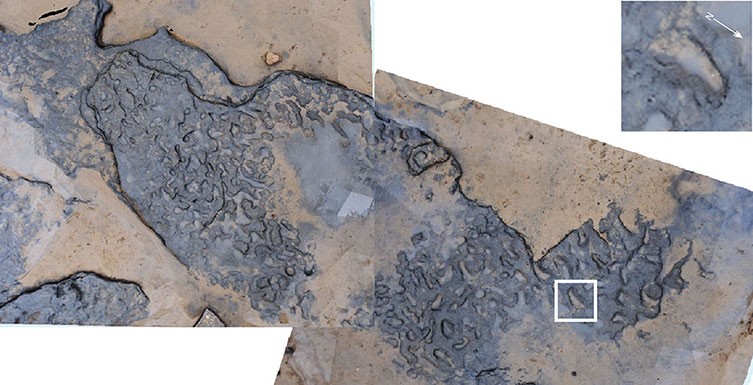 |
An area of the 900,000-year-old footprints found at Happisburgh, Norfolk, with an enlarged photo of footprint eight showing toe impressions |
Other star specimens in this part of the gallery include the Broken Hill skull of Homo heidelbergensis - the first early human fossil found in Africa - and the Gibraltar 1 skull, which was the first adult Neanderthal skull ever found. Gibraltar 1 has recently been sampled for ancient DNA, with the results eagerly awaited.
A new view into the past
With advances in the extraction and analysis of ancient DNA and the sequencing of both Neanderthal and Denisovan genomes, scientists are revealing in more detail how our ancient relatives could have looked and behaved. They are also pinpointing what exactly we have inherited from our closest ancient human relatives.
We know that interbreeding with these ancient humans allowed Homo sapiens to acquire genes that improved their chances of survival, and some of these genes remain in many of us today.
Some of the DNA inherited from Neanderthals seems to have been involved in boosting immunity, for example, while a gene variant inherited from Denisovans - present today in Tibetan populations - may enable better survival at high altitudes.
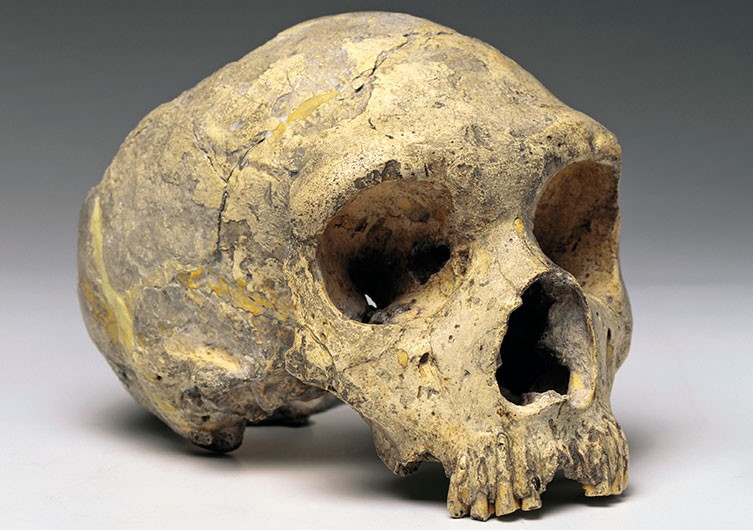 |
| Gibraltar 1, the first adult female Neanderthal skull ever discovered |
Out of Africa
The final part of the gallery explores how our species, Homo sapiens, originated in Africa, before dispersing around the world and becoming the only surviving species of human left today.
Modern humans evolved in Africa around 200,000 years ago. They have a higher and more rounded brain case, smaller faces and brow ridges, and a more prominent chin than other ancient humans.
Casts on display include modern humans fossils found in Africa (about 195,000 years old), Israel (around 100,000 years old) and Australia (around 12,000 years old).
These fossils show that rather than springing fully formed from Africa, typical modern human characteristics instead built up over time. They also suggest that there may have been at least two waves of migration out of Africa - one dating back to around 100,000 years ago and another to around 60,000 years ago.
Outside of Africa, we are all descendants of those who left in that second wave of migration.
Evolving culture
Artefacts in this final zone of the gallery highlight the craftsmanship and ingenuity of modern humans, as well as early symbolism and cultural practices such as cannibalism.
 |
| Human skull fashioned into a cup. Museum scientists Dr Silvia Bello and Prof Chris Stringer have been researching cut marks on bones from Gough's Cave in Somerset, England, to understand more about the behaviour of humans who lived there 14,700 years ago. | Read more |
A changing story
Human evolution is a puzzle with thousands of fossil pieces and billions of DNA fragments. As new fossils continue to be uncovered and added to the human family tree, new dating techniques and climate data are providing a more accurate picture of the conditions in which our ancient relatives evolved.
Improved DNA techniques will help determine where each species fits within the family tree, and give us further insights into recent and ongoing human evolution.
Museum scientists and collections are playing a key part in shaping one of the most exciting fields in science today. We're delighted to be able to show visitors some of this work in the gallery.
---
How we became human
By David Urry and Lisa Hendry
Today, we sit alone on the only remaining branch of the human family tree. But we are only one character in the story of human evolution.
To truly understand who we are, we must look at how we got here and the key physical traits that make us human.
Bipedalism
The ability of humans to comfortably stand on two feet for extended periods of time marks us out from almost all other animals.
This feat has come about over time through a series of anatomical changes to our skeleton, affecting our cranial base, spine, pelvis, femur, knees and feet.
 |
| Australopithecus sediba (centre) and modern human (far right) skeletons are adapted to walking upright, but a chimpanzee's skeleton (left) isn't. |
These features serve as useful identifiers in the fossil record of likely bipedalism in our ancestors, the earliest evidence of which may come from the six-million-year-old Orrorin tugenensis.
But it's not until Homo erectus came on the scene about 1.9 million years ago that we see the long-legged form, similar to our own, that makes us so well suited to running and walking over long distances.
Big brains
Humans are big headed - our brains are around three times larger than would be expected for an animal of our size.
The brains of our early hominin relatives (species more closely related to us than to chimpanzees) were not especially large. Australopithecine brains were little bigger than those of other apes, about the size of a grapefruit.
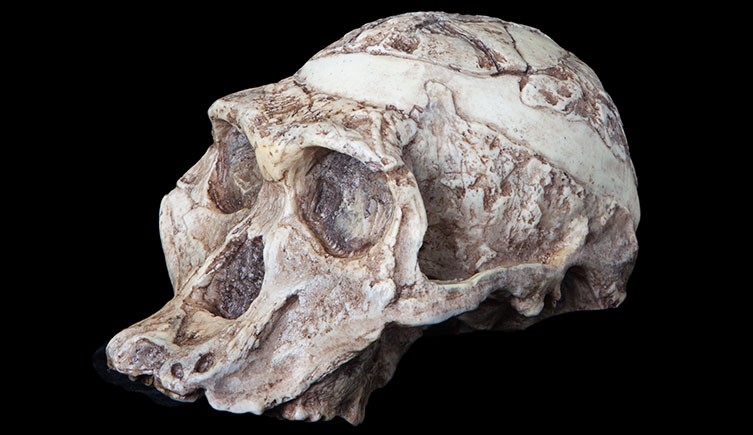 |
| Australopithecus africanus had a much smaller brain than humans |
It isn't until the emergence of the genus Homo that we begin to see a more significant increase in the size of brains, dominated by a swelling of the cerebral cortex.
Between 1.8 million and 700,000 years ago the average brain size of Homo erectus doubled, and the brains of Neanderthals and Homo sapiens are even larger.
What caused this drastic increase in size is unclear, but it was made possible by changes in diet that allowed humans to extract more energy from their food. The production of tools and fire that allowed pre-processing of plant foods - reducing the work load of jaws, teeth and digestive systems - probably played a part. So did access to meat, a rich source of protein.
A larger brain is clearly linked to a number of distinctly human traits: the ability to create more complex tools, more advanced hunting techniques, complex social structures and the advent of language.
 |
| This 400,000-year-old spear tip made from yew wood was whittled to a point with a stone tool. It would have made a lethal weapon for hunting with. |
Similar sized sexes
Although not as obvious a human trait as some of the others, a reduction in sexual dimorphism - the difference in size and shape between males and females - is closely linked to one of the most important human features of all: widespread cooperation in a population.
High sexual dimorphism in most primates is associated with competition between males for access to females. Most commonly, this leads to males having much larger bodies and canine teeth, which are used in displays of aggression.
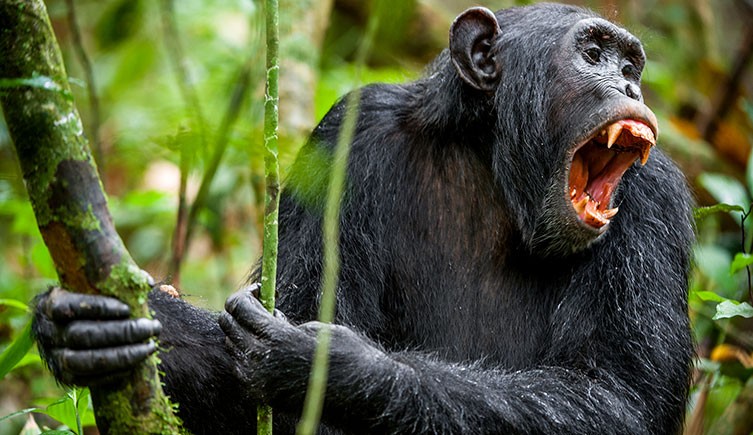 |
A chimpanzee bares its large canine teeth. Male chimps have much larger canines than female chimps and use them to signal aggression, unlike humans. © Sergey Uryadnikov/ Shutterstock.com | Read more |
A chimpanzee bares its large canine teeth. Male chimps have much larger canines than female chimps and use them to signal aggression, unlike humans. © Sergey Uryadnikov/ Shutterstock.com | Read more
All known hominins have smaller canines than our closest living relatives, the chimpanzees and bonobos. Among some of our early hominin relatives, such as Australopithecines afarensis, we see quite a large difference in body size between males and females. But species in the genus Homo start to show a level of sexual dimorphism similar to our own.
Why is it an important trait for becoming human?
Since reduced sexual dimorphism correlates with less aggression between males, it is likely to be associated with greater cooperation within a population and probably made the development of successful societies and civilisations much easier.
Childhood
The existence of a childhood appears to be an important development on the road to becoming human. We define it as the period of time following infancy, when the youngster is weaned but is not able to care for itself.
It is essentially an extended period of growth with continued rapid development of the brain. This period allows us to learn the complex set of skills and social intricacies that equip us to exist in complex human societies.
Childhood also brings with it another, less obvious benefit for human populations.
Unlike most primates, we are still relatively helpless once we stop feeding on our mother's milk. A child is therefore still dependent on the care of others. Importantly however, provision of care is not limited to the mother, but could instead come from a grandmother, elder sibling, or another close relative.
This frees up the mother's time, enabling her to engage in other activities and also to have another child much sooner than would be possible if she was still nursing.
An extended childhood appears to have first developed in the Homo genus. The beginnings of this are found in Homo erectus after about 1.9 million years.
A precision grip
Although other animals use tools, our mastery is second to none, and distinctly human. Ultimately, it stems from the development of a precision grip, the result of changes to the anatomy of the hand. One of the key anatomical features that has enabled this is the presence of a little projection of bone called the metacarpal styloid process.
This bone allows us to apply greater amounts of pressure to the wrist and palm. Together with changes in the proportion of our digits, it means we can squeeze objects between our thumb and the tips of our fingers.
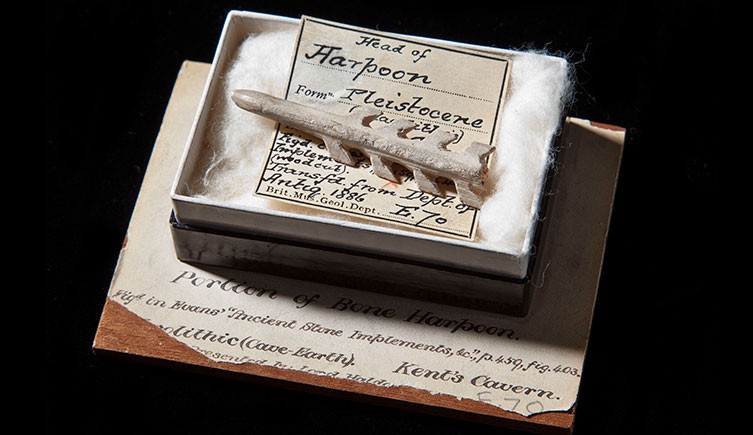 |
| Considerable manual dexterity was needed to carve this harpoon point from reindeer antler. Around 14,000 years old, it was found in Kent's Cavern, Devon. |
A chimpanzee, by contrast, is unable to touch the tip of its thumb with the tips of all its fingers, and as a result does not have the same manual dexterity.
Some of our more distant relatives such as Australopithecus afarensis, including the famous fossil known as Lucy from 3.2 million years ago, also lacked a precision grip. But recent research using CT scanning suggests that Lucy's close cousin, Australopithecus africanus, may have possessed the required anatomy and grip to wield stone tools more than three million years ago.
This grip may have become even more refined by the time of Homo erectus 1.8 million years ago. Coupled with an increased intelligence, it has equipped humans with incredible influence over the world around us.
This film shows the making of a Levallois core and flake, an innovative stone tool developed by the Neanderthals and early Homo sapiens.
Around 300,000 years ago, they began to shape stone cores from flint that they could carry as a kind of toolkit. They would strike off flakes from this portable core and skilfully turn them into tools for specific purposes such as cutting, scraping, piercing and carving.
You can learn more about our origins and evolution in the Museum's Human Evolution gallery and this feature about the origin of our species.


No comments:
Post a Comment